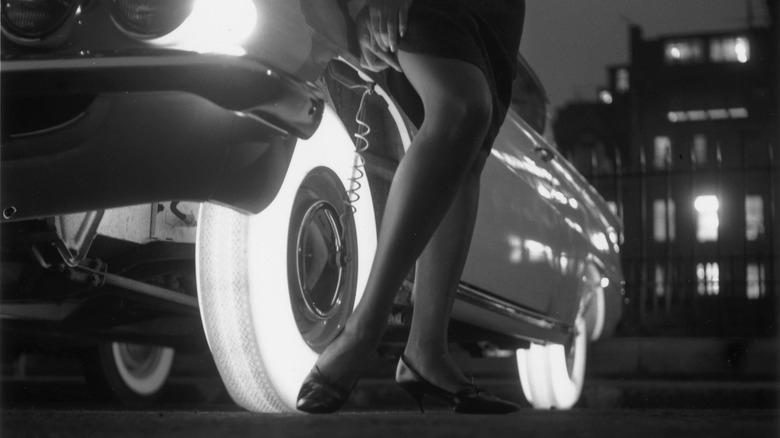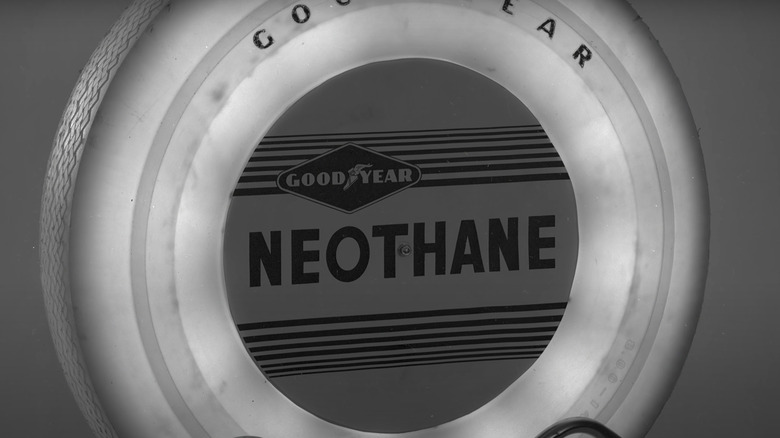Why Goodyear's Bizarre Glowing Tires Were A Failure
People love their cars; they soup them up and modify them in every possible way, from hydraulics on low riders to blowers on hot rods. Enthusiasts chop tops, add spoilers, light up the undercarriage with neon lights, and deck out their rides with big tires, skinny tires, white walls, and slicks. You'd think a company would be able to capitalize on people's insatiable desire to pimp their rides by making tires that light up. Well, the Goodyear Tire & Rubber Company did ... way back in 1961, in fact.
According to The Drive, a chemist working at Goodyear by the name of William Larson and coworker Anthony Finelli created a translucent polyurethane material called Neothane, which was designed to be poured into tire-shaped molds, after which point it would be baked in an oven at 250 degrees Fahrenheit (via IEEE Spectrum). Because of this, making Neothane tires was far easier than making traditional tires, prompting Goodyear to go so far as to claim the synthetic material was better than its traditional rubber counterpart. That, however, didn't prove to be the case for long — while the translucent appearance made it possible to create glowing tires, the final products had the tendency to melt while driving.
Goodyear was going to light up the night
With Neothane, Goodyear was going to revolutionize the tire industry. The material would allow them to make tires easier, plus the new liquid compound had one other very marketable upside. A byproduct of baking this synthetic rubber was that it became translucent, and because of that Goodyear could dye the tire any color it wanted. In fact, in 1962, John J. Hartz, who was Goodyear's development manager, was quoted by The Drive as saying, '"Someday a wife may tell a husband: 'Charlie, go out and change the tires. I'm wearing my blue dress tonight.'"
But Goodyear didn't stop there. Because Neothane was semitransparent and allowed light to pass through, engineers attached a string of 18 light bulbs to the center of the wheel; when turned on at night, they made the whole tire glow, lighting up the wheel wells and the ground underneath the car. The driver could even control which tires were illuminated from a panel near the steering wheel, allowing them to be used as brake lights or even turn signals. It was quite a sight, especially in the early 1960s.
The 1960s weren't ready for neon tires
Several problems with these tires quickly appeared despite the early tests that showed Neothane was smooth and quiet. First, it simply didn't perform well in wet weather, rendering it dangerous to use in rainy or snowy climates. Second, hot weather and heavy breaking caused the tires to melt. Neothane wouldn't work in hot environments like Las Vegas ... or anywhere it got hot. Regular driving made the tires so dirty that they had to be cleaned after every trip, too, otherwise the dirt would blunt the lighting effects.
Last but not least, according to a Life Magazine article found by IEEE Spectrum, motorists became so transfixed by the bright colors and neon lights that they were running through stop signs and stoplights or outright braking in the middle of the road to stare. Goodyear remained undeterred and set out to make modifications, but it soon became apparent that the new synthetic compound would be too expensive to use in tire manufacturing, and its idea for "one of the most dramatic tire developments in the history of the industry" came to a screeching halt.

